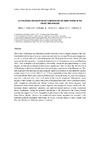Identificador persistente para citar o vincular este elemento:
https://accedacris.ulpgc.es/jspui/handle/10553/17953
| Título: | Late Pliocene and Quaternary Eurasian locust infestations in the Canary Archipelago | Autores/as: | Meco, Joaquín Muhs, Daniel R. Fontugne, M. Ramos, Antonio J.G. Lomoschitz, Alejandro Patterson, Deanna |
Clasificación UNESCO: | 24 Ciencias de la vida 2416 Paleontología |
Palabras clave: | Sea-Level Changes K-Ar Ages Littoral Deposits Ice Core Islands, et al. |
Fecha de publicación: | 2011 | Publicación seriada: | Lethaia | Resumen: | The Canary Archipelago has long been a sensitive location to record climate changes of the past. Interbedded with its basalt lavas are marine deposits from the principal Pleistocene interglacials, as well as aeolian sands with intercalated palaeosols. The palaeosols contain African dust and innumerable relict egg pods of a temperate‐region locust (cf. Dociostaurus maroccanusThunberg 1815). New ecological and stratigraphical information reveals the geological history of locust plagues (or infestations) and their palaeoclimatic significance. Here, we show that the first arrival of the plagues to the Canary Islands from Africa took place near the end of the Pliocene, ca. 3 Ma, and reappeared with immense strength during the middle Late Pleistocene preceding MIS (marine isotope stage) 11 (ca. 420 ka), MIS 5.5 (ca. 125 ka) and probably during other warm interglacials of the late Middle Pleistocene and the Late Pleistocene. During the Early Holocene, locust plagues may have coincided with a brief cool period in the current interglacial. Climatically, locust plagues on the Canaries are a link in the chain of full‐glacial arid–cold climate (calcareous dunes), early interglacial arid–sub‐humid climate (African dust inputs and locust plagues), peak interglacial warm–humid climate (marine deposits with Senegalese fauna), transitional arid–temperate climate (pedogenic calcretes), and again full‐glacial arid–cold climate (calcareous dunes) oscillations. During the principal interglacials of the Pleistocene, the Canary Islands recorded the migrations of warm Senegalese marine faunas to the north, crossing latitudes in the Euro‐African Atlantic. However, this northward marine faunal migration was preceded in the terrestrial realm by interglacial infestations of locusts. □Locust plagues, Canary Islands, Late Pliocene, Pleistocene, Holocene, palaeoclimatology. | URI: | https://accedacris.ulpgc.es/handle/10553/17953 | ISSN: | 0024-1164 | DOI: | 10.1111/j.1502-3931.2010.00255.x | Fuente: | Lethaia [ISSN 0024-1164], v. 44 (4), p. 440-454 |
| Colección: | Artículos |
Los elementos en ULPGC accedaCRIS están protegidos por derechos de autor con todos los derechos reservados, a menos que se indique lo contrario.
